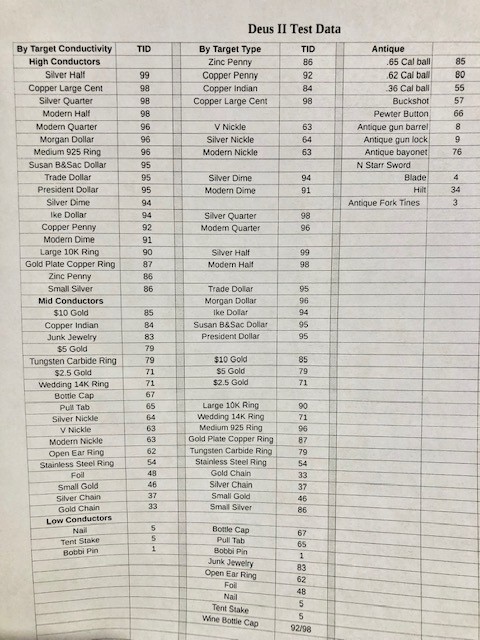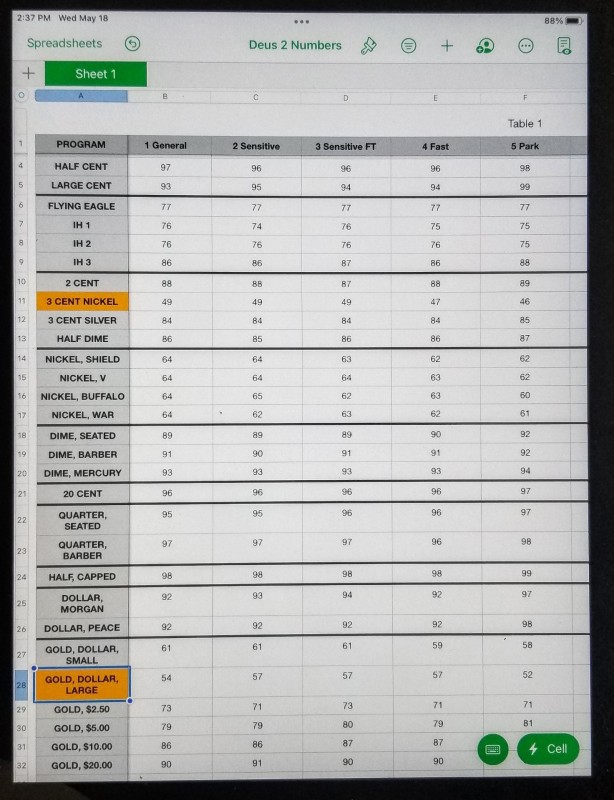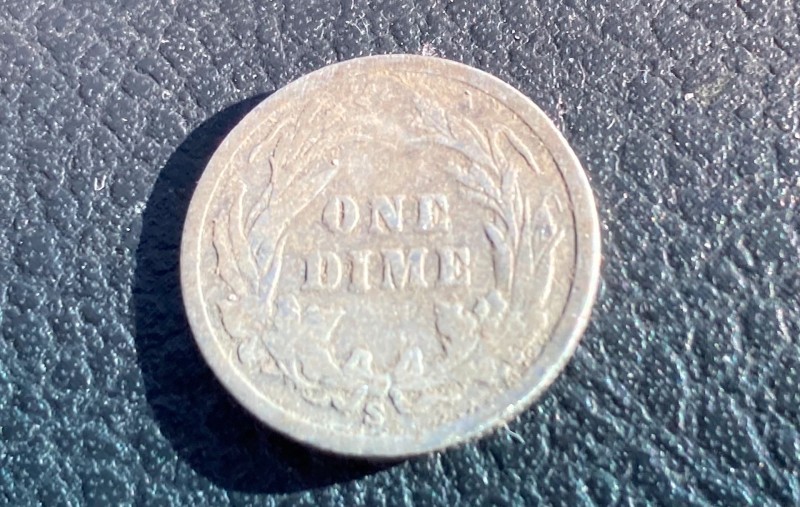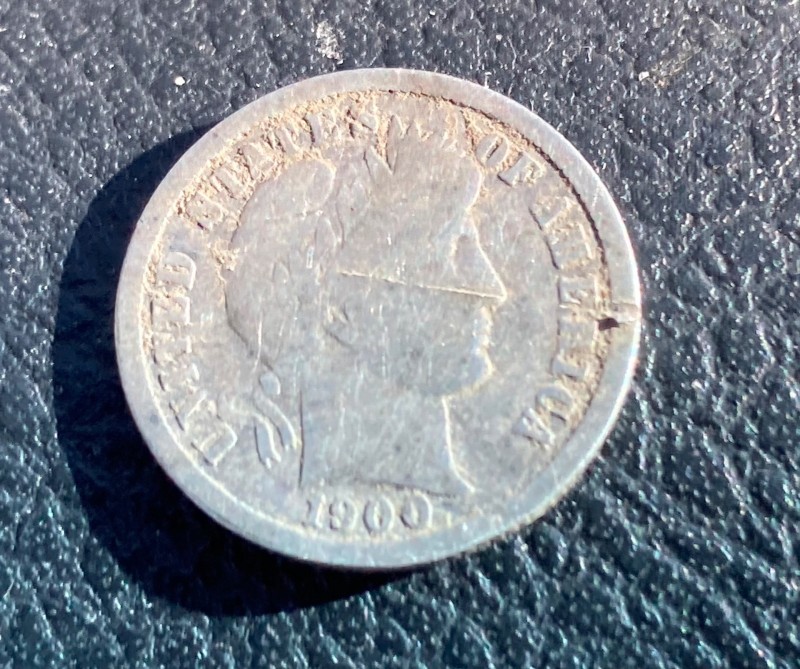-
Posts
179 -
Joined
-
Last visited
Content Type
Forums
Detector Prospector Home
Detector Database
Downloads
Posts posted by mudwhale
-
-
3 hours ago, Calmark said:
I remembered one thing about the Deus 2 I would suggest 9 inch coil users to try. I mentioned it somewhere in another post on this site, but it bears repeating.
Remove your velcro arm strap and try swinging it without. I don't remember in which video I first saw somebody using their Deus 2 without the strap, but once I got mine I didn't put the strap on it and haven't missed it. In fact, I find it much more convenient and quick to use without the strap. No more need to slide my arm out of the cuff and no more bunching up of my long sleeved shirts. Time saved equals more targets dug in the long run.

A very underrated way to use the Deus 2 and I highly recommend at least trying it. Your experience may vary with a bigger and heavier 11 inch coil.
I have never installed the strap on any of my detectors. I have never needed them.
Great post. 👍
-
Nice read Sir! 👍
-
Unlike other detectors Deus only blocks the audio which doesn't affect depth. The only setting on the Deus II that will affect depth is the Reactivity setting. This determines how long the coil stays on between targets.
-
9 hours ago, Jeff McClendon said:
I don’t use notches unless the trash or hot rocks are just unbearable.
I do use tone bins to help learn the detector.
Tone bins were 0 to 10, 11 to 59, 60 to 64, 65 to 88, 88 to 89.
I set my tones to pitches I like and can remember…….but I am a classically trained musician so my tone choices are very subjective.
thanks for asking
I used the word "Notches" by mistake and meant tone settings as you refer to them as Bins. Thank you for sharing and I will test this this weekend.
-
1 hour ago, Jeff McClendon said:
I have been out a few times during some insane weather with the new Deus 2. Finally today we had some good weather conditions and good soil moisture levels in the local parks for perfect deep target conditions.
I was using the 9" coil in stock General mode. The only adjustments I made were to use Square Wave audio and to set 5 tone bins for iron, low conductor gold/aluminum, US nickels, mid conductor aluminum/zinc penny, and the last bin was for copper pennies, dimes, quarters and any silver coins or jewelry. I only dug targets with tones and IDs in the US nickel and copper penny/silver ranges. I walked over hundreds of other trash targets that were visible or heard along with what were probably zinc pennies/small shot bottle aluminum screw caps.
I had hunted this park originally with Deus 1 and later gridded part of it with the Equinox. The Equinox has tallied 8 silver dimes and 27 wheat pennies at this one park. It is the kind of place where most of the good targets are 6 to 8"+ deep and are covered with a dense surface to 6" matting of can slaw, pull tabs of all sorts, and thousands of steel crown bottle caps and aluminum screw caps.
I deliberately hunted mostly the area that had been gridded with the Equinox. Due to the numerous aluminum targets that crowd into the US nickel range on the Equinox (11,12,13) it has been really hard for me to hunt nickels and gold rings that respond with those numbers since I would have to dig hundreds of targets in a small area and might only move 10 feet during a 2 hour hunt. Denver Parks and Rec. would also have something to say about hundreds of dig holes in a 10'x10' area......not happening.
Limiting that US nickel bin to 60 to 64 on Deus 2 cut way down on the aluminum targets that I dug today. I easily located 6 nickels (one was a 1934 Buffalo) and all were in the 6" to 8" range. They had no doubt nickel bin tones and IDs. I only dug 4 other targets in that range. 3 were detached, deep beaver tails from ring pulls and one was a thick, nickel sized piece of can slaw. Very impressive since Deus 1 for instance would up-average US nickels from 62 to the low 90s after 3" depth. It would do the same to pull tabs/can slaw........extremely annoying considering the price and reputation of the original Deus and one reason I am very glad to have a Deus 2.
Detecting targets in the copper/silver bin was super easy. I did experience a little up averaging of 6" to 8" copper pennies and clad dimes but I quickly learned what Deus 2 was telling me. Those deep high conductors in the 8 to 10 mineralization bar dirt that I was hunting in had mostly good numbers. The up-averaging happened more in the Deus 2 audio which had the correct high tones but also had some sporadic iron tones mixed in. Occasionally I would see a 00, 01 to 05 pop up along with the correct 90 to 95 depending on the target. I checked each hole that had some iron responses mixed in with high conductor responses and there were no man-made iron targets present. I managed quite a few copper Memorial pennies, one Wheat, several clad dimes and two really deep late 1960s quarters. Most of these targets were on edge or at least tilted.
So, Deus 2 as opposed to Deus 1, is an outstanding modern trashy park detector for sure in even moderate to high mineralization. Very impressive.
Next time I will go after some of the deeper, more iffy signals. Today this park was full or city workers who were trying to deal with all of the broken limbs and damaged trees from our weekend late May snow/wind storm. I did not want to look like I was digging too deep or for too long in one spot.
Jeff
Excellent read!
Please describe your notch settings if you could. I am using 3 tones now and want to play with 5 tones.
Thank you Sir!
-
6 hours ago, ColonelDan said:
I decided to expand the test I posted on another thread in this forum. The question was raised concerning the TID differences among the various programs. For this test, I used a silver walking liberty half dollar and a modern Kennedy half dollar separately scanned by each of the Deus 2's 12 factory programs. I conducted a frequency scan prior to each program and EMI didn't seem to be a factor. My purpose was to determine just how much of a TID variance there was among these programs on the same targets.
Program Max Frequency Silver Half Modern Half
1. General: 40kHz 98 97
2. Sensitive 40kHz 98 97
3. Sens FT 40kHz 98 97
4. Fast 40kHz 98 97
5. Park 24kHz 99 98
6. Deep HC 14kHz 99 99
7. Mono 16.5kHz 97 96
8. GoldField 40kHz 98 97
9. Relic 24kHz 99 98
10. Diving 14kHz 99 99
11. Beach 24kHz 99 99
12. Beach Sens 40kHz 99 98
Note: Although the results show a fairly consistent relationship between the TIDs throughout the 12 programs, the silver half TID was solid and pretty much unwavering. The modern half however had a tendency to vary by a point or even up to 3 points as it settled in on the most common of the TID numbers reported here.
Again, these 12 were all stock factory programs; no adjustments were made to any of the internal settings. I would hazard a guess that results from the adjusted settings within a custom program might generate somewhat different TID results.
Thank you! Maybe you could replicate the test in the other thread between the Halves and a silver quarter?
-
1 minute ago, CPT_GhostLight said:
I went out with th Deus II last weekend to an old Colorado mining ghost town and was very happy with its performance in an iron and nail infested site. You can see the whole article in the Coin & Relic section:
Nice Write up!
-
12 hours ago, Ogliuga said:
Hi all. Have you ever noticed more depth on wet ground than on dry ground? During my last test, I have the 0.71 firmware, the little low conductor target couldn’t be detected in the bottom of a 8” hole so I tried again with a 6” one and was ok. 1 month ago, with the V07 firmware, D2 could detect that target in the bottom of a 8” hole. But couldn’t detect it in the bottom of the same 8” hole with 0.71. So, or there is this big difference between wet and dry soil or it’s a V.071 issue..2.5” is a lot..
I believe Gary on his channel stated the General Program was best for wet soil.
-
On 5/18/2022 at 5:51 AM, ColonelDan said:
I tested some of the more common targets we might find at the beach and on land just as a "ballpark" reference in my on-going effort to transition from Minelab to XP.
These results are from my custom Beach program that I use most often on our beaches.
Be advised, the target TID's listed were derived from air tests. TIDs from targets found in sand or soil can be expected to vary somewhat. Your results conducted under similar conditions may also vary to some degree.
Recognizing that metallurgical composition of the many targets we find varies considerably, I'm still in the process of trying to determine an acceptable cut off tone break between low and mid level conductors on the Deus II scale....admittedly, a search that may be in vain. 😆
Thanks for the nice ID chart!
On 5/18/2022 at 5:51 AM, ColonelDan said:I tested some of the more common targets we might find at the beach and on land just as a "ballpark" reference in my on-going effort to transition from Minelab to XP.
These results are from my custom Beach program that I use most often on our beaches.
Be advised, the target TID's listed were derived from air tests. TIDs from targets found in sand or soil can be expected to vary somewhat. Your results conducted under similar conditions may also vary to some degree.
Recognizing that metallurgical composition of the many targets we find varies considerably, I'm still in the process of trying to determine an acceptable cut off tone break between low and mid level conductors on the Deus II scale....admittedly, a search that may be in vain. 😆
On 5/18/2022 at 3:41 PM, JoeInMemphis said:I get a different number depending which program I use, and I'd be curious to know if it's a type 1 a type 2 or a type 3 gold coin that Chase gave us the numbers for (I get a different number between the small gold dollar and the large gold dollar). I have been playing around doing the same thing trying to learn my new machine.
Thanks Dan and Joe for the excellent charts!!!
🙌👏👏👏🖖👌✌👍🤙🙂
-
20 hours ago, NCtoad said:
It was a silver half dollar that came in at 99. The Morgan silver dollar came in at 96. I find that strange. Can someone explain to me why a the larger silver dollar came in lower than the silver half?
It could be the year the Half was minted. My 1958 Benjamin is 90% and my 1967 Kennedy is 40%.
-
What is VERY important is for folks to use a USB port of 2.0 and above. XP states this in the instructions.
-
24 minutes ago, NCtoad said:
Ok, I assumed wrong in my thinking that everything that hits below the disc setting in full tones gives an iron tone. I just tested this with a rusty nail that rings up as 3. If I set my disc to anything above 3 I get no tone at all. 3 and below gives me a low iron tone. I tested this in general 1 FT and program 3 (sensitive FT). I also tried it with a zinc penny and a shotgun shell headstamp. The penny came in at 83 with a high tone with disc set at 83 or below. Any disc setting above 83 and I get no tone (silence). Same with headstamp which rang up at 72.
So I tried the same experiment in pitch. In pitch tones anything that rings in below your disc setting comes in with an iron tone. Doesn’t matter if ferrous or non-ferrous. For example, that zinc penny will come in with an iron tone if I set my disc at 84 or higher.
i really wish full tones would act in the same manner! There’s many instances where I want to hear the iron below my disc setting in full tones. I really like full tones, but if the disc is working like a notch where you don’t hear anything then disc settings don’t seem to serve a purpose imo. For example if I’m hunting in the woods and want to hear iron to see where there was activity I can set my disc to 6 or so. But then I should also be able to notch out small foil so I don’t hear that. I guess I’ll just have to set my disc really low like 0 or 1.
Sir
Full tones, unlike any other audio mode, uses a different scale for iron audio. If you disc -6.4 in full tones you will hear all the iron. I disc up until it is there in the audio but just enough to know I am around iron. All the other tone modes work with a disc of 6 or whatever your preference. Full tones is the audio mode that can be confusing. I had to ask a lot of questions myself because the manual confused me.
Cheers
-
2 hours ago, Denny said:
Hit the grassy area for 5 hours on Sunday tried hard to find another gold nugget didn’t happen but manage to dig up a 1900 barber dime. I’d 82-83-88 one way and 81-82 the other. I believe the coin was on edge 4-5 inches deep one of the reasons I bought the D2. Barber coin not corroded like many this one is just worn down from use.
Denny
Sweet Find!! 👍🤙
-
2 hours ago, NCtoad said:
Just wondering: if I’m using full tones and have my disc set to 6 so I can hear low tones on iron, but I also set a notch from 6-35 to knock out foil and small canslaw, I will not hear any tone from 6-35, correct? I want to be able to hear low tones on iron only. However, if I set the disc at 35 with no notch at all, I’ll hear low tones on small foil and such all the way to 35. Is this correct? Again I’m talking when I’m in full tones.
Using Full Tones,I start to lose iron tones at a disc around 5. Maybe my hearing loss? I run a disc around 3-4 to just start to hear the iron. I don't use notch much except in Park program. I have been using 3 and 4 tones with custom tones as a filter instead of notching. You can try setting disc to as low as you7 want and try the iron audio levels under the Disc menu.
Cheers and HH
-
6 hours ago, brys said:
discrim at 7 or do you reduce it ? for woodland
If I am running 3 tones, I disc at 6. If I am running full tones I set the disc at 3 so I can just start to hear the iron.
-
20 hours ago, Chase Goldman said:
No that's not the way it works, Mudwhale. The WS6 doesn't turn on the remote on power up if paired, only the other way around. The remote will turn on the WS6 on power up, but not the other way around.
Chase
Sorry for that one but my brain died! LOL! 🤣
-
18 hours ago, Chase Goldman said:
Pretty good summary but with some inaccuracies.
Pretty Accurate: Deep HC does punch deep and favors high conductors because of its frequency profile (4.76 khz and 14.3 khz) and lower than average reactivity for the non-beach modes. Not good for areas with high trash target densities (hence woodlands).
Not So Accurate: Deep targets do not take longer to process.
But they are more easily bypassed at depth due to their reduced signal strength and profile, so going slow is a better approach with this mode.
Park runs 8 and 24 khz.
More info on the frequency combos used by the Deus 2 programs below...
Chase
I used the wrong word, "Processed", instead of Transmit and receive speed. The processing time is the same but the transmit and receive signal is slower with lower frequencies. I played with this with my Nokta Impact testing swing speed using 4khz and 20 khz over a buried 4" silver quarter. 20Khz hit it at any swing speed. 4 khz only saw and ID'd it with a slower swing speed. 4 khz missed it completely with faster swing speeds. Between 20 khz and 4 khz is a factor of 5 in speed. Sorry for the miswording as I can see how it could be confusing.
-
59 minutes ago, Naildiggerpro said:
Ws6 works fine mudwhale but remote does absolutely nothing
Definitely a remote issue then Sir. Sorry for that!
-
20 hours ago, Naildiggerpro said:
My computer is 5 years old it didn’t have anything to do with the USB port I’ve updated twice before and all went fine , I see other people having the same issues now I’m just waiting to hear back from xp on what to do next I hope this doesn’t happen all the time because I really like this detector, but this is a pretty serious problem for only having it for a month oh well I guess I have the ws6 headphones to detect until it gets repaired . Good thing it comes with a 5 year warranty
Just a question. If you turn on the WS6 is the main remote still dead? It should come on if they are paired.
-
45 minutes ago, brys said:
in a gary article in TH mag he mentions its good for woodland which i do ,his comments are strange ''a much slower program that needs to be used with caution as it has a lot more punch ,quite possiby too much for some situations'' ,and recomends it for clean soil and woodland
how deep on woodland is it??
whats that all about ??
Because Deep HC uses 4 khz and 14 khz it runs better when you hunt with a slow swing while hunting. I used it in the deep woods today and it gives a better ID with a slower swing. When the frequency is down to 4khz it punches deep in the ground and it takes slightly longer to process the signal. Another great program for the woods is the Park program with the factory notches taken out. I believe it runs 12 khz and 24 khz.
-
7.1 went in fine for me on Remote and WS6. One thing I think is important is to make sure you are using a USB 2 port.
Software that is written for USB 2 can get scrambled if you use a USB 1 port. I've seen this happen before.
-
4 hours ago, CPT_GhostLight said:
Please forgive such a newbie question, but I've reread the manual a few times and searched other resources, but I can't find an explanation of why you would want to reduce discrimination below zero. I understand the basic function of discrimination, but what would be the practical reason to drop it to -6.4 or any negative number if iron comes in at zero to about 10? Can anyone help me out with this basic concept? What am I missing here? Thanks!
The description in the manual states while running "Full Tones" mode to lower the disc as low as possible to hear the iron sounds. I have found if you lower the disc to about 4, you can just about start hearing iron tones. Around a disc of 5, they get very faint. In "Full Tones" if you want to hear the iron and the other objects in all their glory, the -6.4 disc is where you need to be. The only time you would want to ever disc to -6.4 is when in Full Tone audio. The stock programs have an average disc setting of 6 and do not use full tones. Full Tones uses a different scale for Iron audio.
-
See Below edited reply
-
2 hours ago, SwiftSword said:
I hope this makes its way to someone at XP.
I detect mostly with the Deep HC program with Square Full Tones. I find myself straining to hear deep targets, while surface trash is incredibly loud. I understand this functions is a depth indicator, but I would love to have the option to reverse its direction, so that deep targets are loud, and shallow ones soft. I understand I can increase Audio Response to make the deeper targets louder, but that doesn't help with the shallow targets, and just makes everything sound the same.
Thank you!
Oliver
Mr Swift
Over on the Friendly site in the All About Detectors section, a gentleman known as TNSS have been feeding suggestions to XP and is in communication with them. Copy what you wrote here and put it on his thread.
I think this would be a great feature as I hunt Deep HC in full/square audio too. Glad you brought it to light.







Rc Carry Options?
in XP Deus II Forum
Posted